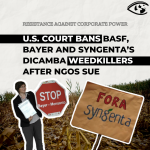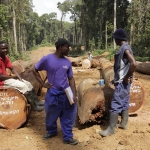USA: Pesticide Drift a Hazard for Californians
A new PAN North America report reveals that several widely-used pesticides are regularly found in California air far from where they are applied at concentrations that significantly exceed levels deemed "safe" by regulatory agencies. Secondhand Pesticides: Airborne Pesticide Drift in California, by PANNA, Californians for Pesticide Reform (CPR), California Legal Rural Assistance Foundation (CRLAF) and Pesticide Education Center (PEC), compares the results of recent pesticide drift monitoring by the California Air Resources Board (ARB) to levels of airborne pesticide exposure considered safe by state and federal regulators.
Pesticide drift is any airborne movement of pesticides away from an application site, including droplets, dusts, gases, volatized pesticides, or pesticide-contaminated soil particles. Drifting pesticides can be invisible and odorless, yet still harmful to health. Susan Kegley, Staff Scientist at PANNA, compares them to secondhand cigarette smoke, "Inhaling even small amounts over time can lead to serious health problems. Urban residents, schoolchildren, suburban dwellers and farmworkers across California are breathing air containing unsafe levels of toxic pesticides."
State and federal regulations ignore 80-95% of pesticide drift by limiting the definition to airborne pesticides during and immediately following application. However, for 45% of agricultural pesticides applied in California, the concentrations of pesticides in air peak long after the application is complete--between eight and 24 hours after application.
While farmworkers' proximity to pesticide applications places them on the front line of pesticide-drift poisonings, rural residents, new suburban communities on the urban fringe, and some urban areas are also at risk. Dr. Marion Moses, a physician, co-author on the report and Director of the Pesticide Education Center, said that children are especially vulnerable. "They absorb more pesticides per pound of body weight than adults in an identical exposure setting, and are less able to detoxify chemicals." Furthermore, early life exposures are linked to impaired growth and development, cancers, and lifelong disabilities.
Near-field (30-500 feet) concentrations found by the ARB monitoring of chlorpyrifos and diazinon--both neurotoxic insecticides that the U.S. Environmental Protection Agency (EPA) is phasing out for home use due to hazards they pose to children--exceeded short-term child reference exposure levels (RELs). Chlorpyrifos concentrations were 184 times the one-year-old child REL, or "acceptable" short-term level, and diazinon concentrations were 39 times the child REL. For the highly acutely toxic fumigant metam sodium, concentrations over 450 feet from the tested field exceeded the short-term child and adult REL by 60 times. Over the long term, lifetime cancer risks from exposure to average concentrations of the fumigant Telone (1,3-dichoropropene) in Kern County measured up to 56 parts per million, far in excess of the cancer risk of one in one million that agencies generally consider the threshold for concern. Ongoing, background exposure to pesticides in the air within areas of high pesticide use also poses considerable long-term health risks.
Pesticide drift is also a threat to the natural environment. Although it is extremely difficult to quantify the extent to which drift impacts ecosystems, studies clearly reveal the adverse effects of pesticides on wildlife. Birds are often poisoned by spray during applications, while aquatic life suffers when waterways are poisoned from application-related drift or from pesticide-contaminated rain.
In addition to health and environmental effects of pesticide-drift, economic losses are also suffered. Organic farmers whose land is contaminated by pesticide drift can fail to achieve organic certification, reducing the value of their crops despite their commitment to alternative, and often more expensive, farming methods. Drift can also disrupt beneficial insect populations that are an integral part of the delicate ecosystem that organic farming relies on.
"Eliminating use of toxic drift-prone pesticides is the way to stop the drift problem at its source," Anne Katten, Pesticide and Work Safety Project Director of CRLAF, stated. "To protect the health of farmworkers and the general public, state and federal agencies must phase out these pesticides and dramatically boost their support for growers to transition to sustainable agriculture."
In response to the report, the California Department of Pesticide Regulation (DPR) agreed that "airborne pesticide drift is a subject of serious regulatory concern," but states that their own analysis did not show unacceptable risks for both short-term and medium-term exposures for some of the pesticides evaluated in the report. "Yes, DPR gets a different answer when they do this analysis," author Susan Kegley said. "For the chemicals in question, we used the risk assessments developed by the U.S. Environmental Protection Agency (EPA) that are based on the most recent toxicity studies. DPR used older toxicity studies or chose toxicity endpoints (the lowest dose that causes an adverse effect in laboratory animals) that were not the most sensitive. For some of the pesticides evaluated in the report, DPR also failed to include the additional uncertainty factor that U.S. EPA uses to take into account the special vulnerability of children. One would hope that DPR would be taking the most health-protective approach possible, but this doesn't appear to be their strategy."
Secondhand Pesticides: Airborne Pesticide Drift in California is available on the PANNA Web site,PANNA
Secondhand Pesticides: Airborne Pesticide Drift in California is available on the PANNA Web site,PANNA
Sources: Secondhand Pesticides: Airborne Pesticide Drift in California, Susan Kegley, Anne Katten, & Marion Moses, Californians for Pesticide Reform, 2003; PANNA Press Release, Airborne Pesticide Pollution Regularly Exceeds "Acceptable" Health Levels, May 7, 2003 (in English or Spanish); Maps of Pesticide Use, PANNA Maps PAN Pesticide Database has information on individual pesticides at PANNA Database
- 181 Food and Agriculture



